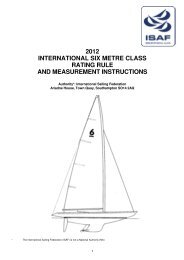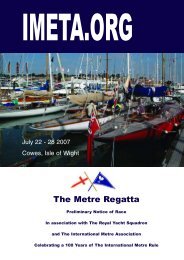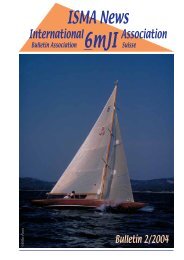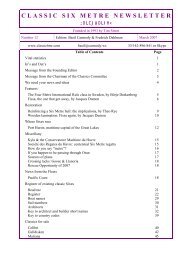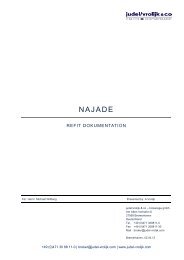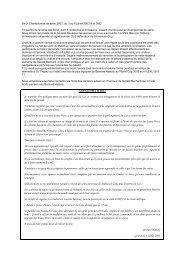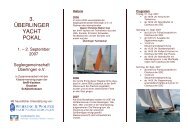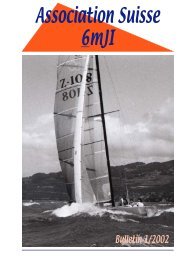CLASSIC SIX METRE NEWSLETTER
CLASSIC SIX METRE NEWSLETTER
CLASSIC SIX METRE NEWSLETTER
Create successful ePaper yourself
Turn your PDF publications into a flip-book with our unique Google optimized e-Paper software.
years my junior, than by the frigate Belle-Poule which, as you well<br />
know, had the honour to return the Emperor’s ashes to France. [The<br />
repatriation of the ashes in 1840 is one of the defining moments of<br />
French history. It was experienced as a resurrection. The mention<br />
here of a frigate is a play on words since the French word for<br />
tumblehome is “frigated”.]. I have always been an advocate of<br />
tumblehome for racing yachts All the Sixes I’ve designed, beginning<br />
with Madame Poulet [1907], have had hard chines and lean lines.”<br />
Pierre Arbaut’s first Six was launched in<br />
1911 and he went on to design 19 in all, his<br />
last being Normand IV of 1930. All his<br />
Sixes were built by yards in the Seine region,<br />
mainly at Le Havre. Two of his Sixes exist<br />
today. They are OE 13 Freya which is<br />
thought to be in Switzerland and FRA 27<br />
Normand III which will be competing in the<br />
2008 European Championships. Arbaut’s<br />
best known metre yacht is his Eight Aile with<br />
which Virginie Hériot won the 1928<br />
Olympics.<br />
- 17-<br />
Virginie Hériot’s F 42 Petite-Aile III (1930), one of Pierre<br />
Arbaut’s last Sixes (photo: Le Yacht, courtesy of the Musée<br />
National de la Marine, Paris)<br />
Noël Gruet is editor of the Cahiers du Bassin, devoted to the maritime history of the<br />
Arcachon basin.<br />
Builder: Henry B. Nevins (1878 – 1950)<br />
The principal builder of Sixes in the U.S., Henry Nevins built about forty of them between<br />
1921 and 1948. He thus ranks 5 th overall, only exceeded by the Europeans Anker & Jensen,<br />
Bjarn Aas, Abeking & Rasmussen and von Hacht.<br />
His domination of the construction of U.S. Sixes is evidenced by fact that he built all but one<br />
each of C.S. Hoyt’s and Clinton Crane’s designs and all but two of Olin Stephens U.S. built<br />
designs.<br />
Among the 19 Nevins-built Sixes that still exist today, one finds such illustrious boats as Bob<br />
Kat II, Clytie II, Djinn, Fun, Goose, Llanoria, Lucie II and Nancy. Others such as Jill and<br />
Madcap are being rebuilt or restored in preparation for next year’s World Cup.<br />
The Nevins yard was located on City Island, part of the Bronx, constituting the most northeasterly<br />
part of New York City. The island marks the end of Long Island Sound as it<br />
becomes Eastchester Bay, which then becomes the East River which borders Manhattan.<br />
Henry Nevins was born in New York in 1878, and wanted to be a doctor but was too frail, so<br />
he decided to work at his hobby, shipbuilding. He apprenticed out to Charles L. Seabury, and<br />
at 29 bought the existing Hansen yard on City Island, renaming it Henry B. Nevins, Inc.<br />
When the yard finally closed in 1954, Time magazine wrote:<br />
“The late, great yachtbuilder Henry B. Nevins was never a man to cut<br />
corners. His City Island yard in New York City seasoned its own<br />
lumber, designed and machined its own fittings, fastened its spars<br />
together with glue made of sour cream, sometimes trimmed them to<br />
the correct balance by weighing shavings. By such attention to detail,<br />
Perfectionist Henry Nevins built more cup-winning yachts than<br />
anyone else.<br />
As his fame grew, boatbuilders came from Scandinavia and Scotland<br />
to work for him. Nevins knew every employee by his first name. Even



